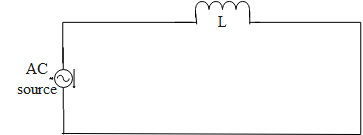
Power dissipated in pure inductance will be:
A. $\dfrac{L{{I}^{2}}}{2}$
B. \[2L{{I}^{2}}\]
C. $\dfrac{L{{I}^{2}}}{4}$
D. zero
Answer
568.8k+ views
Hint: Power dissipation is the resultant of the hindrance in the path of the current flow due to the resistance offered in the circuit. The greater the amount of the resistance applied in the circuit higher will be the energy loss. The resistance is due to the resistive property of the circuit.
Complete step-by-step answer:
Three passive components can be included in a circuit. Resistor, inductor, and capacitor. These components are responsible for the hindrance in the flow of the current in the circuit. This hindrance occurs due to the resistance offered in the circuit.
A resistor is a leaner component that follows the rules as per the ohm's law. The inductor and capacitor are the energy-storing devices. When we take an account of a pure inductor circuit.
A circuit of the pure inductor is shown here,

Power in a circuit is given by,
\[P=IV\cos \theta \]
In the case of an inductor, the voltage leads the current by an angle of $90{}^\circ $
So the power of the circuit is given by,
\[\begin{align}
& P=IV\cos 90{}^\circ \\
& \Rightarrow P=0 \\
\end{align}\]
As the value of $cos90{}^\circ$ is zero the energy dissipated in the case of a pure inductor is also zero.
So, the correct answer is “Option D”.
Note: Inductor and capacitor are energy storing devices. In ideal cases, there are no power losses in pure inductor and capacitor circuits. Power loss is due to the resistance offered by the linear passive component (Resistor) or the resistance of the conductor and other components. In the practical world, every electrical component has its internal resistance including the conductor (connecting wires).
Complete step-by-step answer:
Three passive components can be included in a circuit. Resistor, inductor, and capacitor. These components are responsible for the hindrance in the flow of the current in the circuit. This hindrance occurs due to the resistance offered in the circuit.
A resistor is a leaner component that follows the rules as per the ohm's law. The inductor and capacitor are the energy-storing devices. When we take an account of a pure inductor circuit.
A circuit of the pure inductor is shown here,

Power in a circuit is given by,
\[P=IV\cos \theta \]
In the case of an inductor, the voltage leads the current by an angle of $90{}^\circ $
So the power of the circuit is given by,
\[\begin{align}
& P=IV\cos 90{}^\circ \\
& \Rightarrow P=0 \\
\end{align}\]
As the value of $cos90{}^\circ$ is zero the energy dissipated in the case of a pure inductor is also zero.
So, the correct answer is “Option D”.
Note: Inductor and capacitor are energy storing devices. In ideal cases, there are no power losses in pure inductor and capacitor circuits. Power loss is due to the resistance offered by the linear passive component (Resistor) or the resistance of the conductor and other components. In the practical world, every electrical component has its internal resistance including the conductor (connecting wires).
Recently Updated Pages
A man running at a speed 5 ms is viewed in the side class 12 physics CBSE

The number of solutions in x in 02pi for which sqrt class 12 maths CBSE

State and explain Hardy Weinbergs Principle class 12 biology CBSE

Write any two methods of preparation of phenol Give class 12 chemistry CBSE

Which of the following statements is wrong a Amnion class 12 biology CBSE

Differentiate between action potential and resting class 12 biology CBSE

Trending doubts
What are the major means of transport Explain each class 12 social science CBSE

Which are the Top 10 Largest Countries of the World?

Draw a labelled sketch of the human eye class 12 physics CBSE

Explain sex determination in humans with line diag class 12 biology CBSE

Explain sex determination in humans with the help of class 12 biology CBSE

Differentiate between homogeneous and heterogeneous class 12 chemistry CBSE




